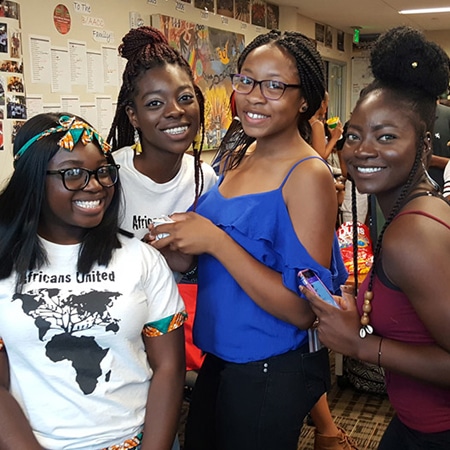Cultural Centers: Bringing a Presence to the Union
Lori Patton Davis, chair of educational studies at Ohio State University and an expert on critical black theory and campus diversity, studied physical campus environments and came to the conclusion in her book Culture Centers in Higher Education that the physical structure and location of a cultural center at a predominantly white institution affects its ability to serve students and provide an inclusive environment.
The time may never be more appropriate for a shift in assessing the placement of cultural centers within the campus environment on both a physical and social level. The concept of a student union encapsulates both these levels, the social and physical, in part based on a history of serving as the locus for generating a sense of belonging for students, including those considered traditionally marginalized. The student union, the central space or living room, of campus, is the perfect spot for this sense of belonging to manifest itself.
It was on a hot, pre-pandemic August afternoon in 2019 that a campus student organization team at Indiana University walked across campus to introduce themselves to those directors and assistant directors of cultural centers tasked with supporting our students. The calendar invitation noted that the cross-campus introductions would be taking place over a 90-minute journey, but that is not how it went: The entire day was spent walking across a sprawling 1,940-acre campus, moving farther and farther away from the hub of student organization offices at Indiana Memorial Union, in an effort to complete what would become a 15,000-step mission visiting every cultural center on campus.
What better evidence was there than that cross-campus hike that students identifying with these centers must travel far and wide to receive services, share time with others in their affinity group, and develop relationships with other campus organizations. That alone might be seen as a strong argument for providing physical space for cultural centers to cluster in or near student unions. There is also evidence that students that identify with a specific group will find increased opportunities for interaction with other groups, including both minority and majority populations, while also affording an opportunity to better understand and respect the values of the institution. Having cultural center operations intertwined with student union operations can, and does, become a win-win for both students and the university.
Student unions are also one of the most heavily trafficked spaces on a college campus, affording an opportunity for it to become a showcase for the diversity and complexity of an institution’s student body … if operational structures allow for space to be prioritized for cultural centers and their student populations. With so many student organizations and affinity groups meeting virtually now, the timing may be right to begin planning alternative space allocation arrangements for when campuses reopen at full capacity
Today, many colleges and universities are focused on creating shared spaces like multicultural centers, providing office and storage spaces for student organizations, reimagining existing spaces for flexible use by various groups, renovating spaces with all-gender restrooms and ablution stations, and more generally, listening to the needs of students of marginalized identity.
Centralized Sense of Belonging for Traditionally Marginalized Students
Higher education has made an incredible investment in promoting diversity and implementing programs and services that facilitate and celebrate these efforts. These university-wide programs often find a home within the student union. Such is the case at the University of Maryland, according to David Reese, coordinator for veteran student life. His office, located in Stamp Student Union, coordinates with other offices to put on programs because, as Reese notes, Stamp Student Union is “the main hub of the campus.” Creating unique cultural spaces within or next to student unions can increase the sense of belonging for students, he said. “Having the veteran-specific events located within the student union brings a sense of belonging to the students we serve.”
The University of Minnesota–Twin Cities provided space on the second floor of Coffman Memorial Union for cultural centers, and researchers Anise Mazone McDowell and Jeanne L. Higbee found “This reflected the commitment to making the centers visible and accessible.” This focus on inclusion and the centralization of cultural centers helped to stimulate a sense of belonging for students, they found.
Remember, they are not called predominantly white institutions for nothing. Higher education is dominated by white faces. White students, representing nearly 53% of the college population, are often entering institutions with a lack of knowledge of other identities, typically based on their personal backgrounds. There are growing implementations of diversity education programs to not only represent those particular populations, but to also educate students of different identities within the campus community. We can see this through the recent legislation signed by California Governor Gavin Newsom requiring all undergraduate students across California State University campuses to take a three-unit ethnic studies course focused on Native Americans, African Americans, Asian Americans, or Latinx Americans.
When cultural centers are implementing events to showcase the resources they provide, celebrate historic events or holidays, or recognize a designated “history” month, how easy can it be for those events to be inclusive for a wide public when note offered at a central, strategic location like the student union? Many cultural centers must utilize existing spaces, even if located at disparate locations where individuals may be less likely to witness or participate in activities. Opportunities to attend these events, even unintentionally, are increased if they are occurring in common spaces where large, diverse groups of students already gather regularly.

Intentional programming is essential to a successful educational experience, but laying out physical spaces for cultural centers within the student union also provides an added opportunity for passive education to occur. Students walking through the student union can see these spaces and in turn perceive the importance the university has put on them. Students can easily view and experience an array of opportunities related to cultural events, programs, student activism as diverse student groups utilize space, allowing for the process of self-education and awareness to foment.
When traditionally marginalized students are moving further off-campus for organizing opportunities, they also tend to not utilize the services in the student union as often, so it’s also good business practice to provide physical spaces within the union so student interactions can increase with revenue-generating resources. The student union is seen as one of the most popular campus spaces, as “the living room of the campus” and the heart of the university, and many are considered auxiliary functions of the university that rely on funding generated from service contracts and direct sales within the space. It makes sense to fill that space with as many students as possible.

Recommendations
- One avenue to consider would be for student union and institutional administrators to begin evaluating actionable steps toward creating an inclusive environment on the campus. For those institutions that do not currently have cultural center spaces anywhere on campus, begin with providing the multicultural student organizations with physical spaces, possibly as shareable, multifunctional office and meeting spaces to conduct initiatives and programming.
- There are multiple passive programming opportunities for cultural centers. Offering booths for the multicultural student organizations to table and provide educational information for other students, and establishing both permanent and temporary displays reflecting cultural heritage, are some of the most common examples.
- Assessing current spaces within the student union and how those spaces are being utilized for diverse student populations, whether or not cultural centers exist in the building, is a starting point. Recognizing many student unions suffer from severe space limitations, and with new construction and renovation expensive, the goal of inclusivity should still remain in any planning processes Ellis shared that a plan to provide cultural centers the needed space in the student center took time, but when leadership made plans to increase equity and inclusion on campus, providing those spaces accomplished those institutional goals at a tangible level. Including diverse voices in decision making, both from the professional and student side, was a requisite for the process to be considered truly inclusive.
- Higher education institutions should focus not only on the racial and ethnic cultural centers, but additional identities as well. Institutions have included LGBTQ+ resource centers, women’s centers, and veteran centers. There are resource centers for commuters, for single parents with children, and for students with disabilities. Reese discussed the sense of belonging veteran students have felt, not only among fellow veterans, but also among the larger campus community. He stated “The goal is not to just have veterans around other veterans, but around other non-veteran students to assist in their transition back to civilian life.” Community building on the broadest of scales, like that seen at these unions that serve as hubs for cultural centers, signals an institutions commitment to inclusivity.
Conclusion
All students deserve a seat at the table, unfortunately, this does not always happen for many underrepresented students on college campuses. When accommodations are made for students to have representation within the most relevant spaces on campus, this serves as a direct reflection on the commitment of the institution. Providing students associated with these centers sought-after space within or near the student union creates a positive and inclusive campus environment and brings an institution’s goal of diversity, equity, and inclusion to the forefront of the campus community. The living room of campus stands apart as the ideal locale for that goal to be met.

